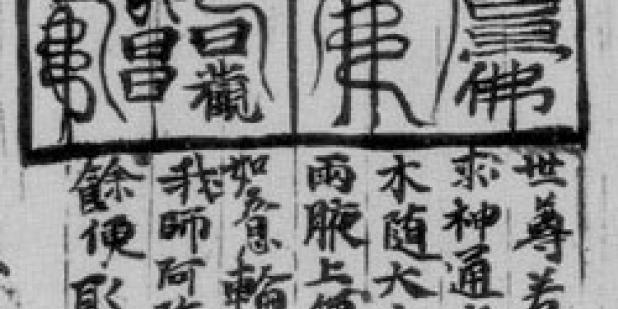Join us for a free one-day workshop for educators at the Japanese American National Museum, hosted by the USC U.S.-China Institute and the National Consortium for Teaching about Asia. This workshop will include a guided tour of the beloved exhibition Common Ground: The Heart of Community, slated to close permanently in January 2025. Following the tour, learn strategies for engaging students in the primary source artifacts, images, and documents found in JANM’s vast collection and discover classroom-ready resources to support teaching and learning about the Japanese American experience.
Buddhist Seal Manuals and the Nature of Dunhuang Buddhism: The Case of P. 3835v.#9
UC Berkeley's Center for Chinese Studies presents a talk by Paul Copp on dhāranī-seal manuals from Dunhuang in the ninth and tenth centuries.

Chinese Buddhist uses of fu-talismans 符 and talisman-bearing seals (fuyin 符印) are among the most characteristic practices of the form of medieval Chinese religiosity known lately as "Buddho-Daoism." Yet aside from being a rather vague label, "Buddho-Daoism," as Christine Mollier has recently pointed out, implies a non-sectarian orientation on the part of the sources that is not always present. In the case of the text that will be the focus of this talk, "Dhāranī Methods of the Great Wheel Vajra" (Foshuo dalun jin'gang zongchi tuoluoni fa 佛說大輪金剛總持陀羅尼法), found as the ninth text on the verso of the Dunhuang manuscript Pelliot # 3835, seals are presented unmistakably as Buddhist – in fact, as forms of Buddhist incantation known as dhāranī (tuoluoni 陀羅尼, zongchi 總持, etc). He will thus take this text's seals as straightforwardly Buddhist and ask what close analyses of dhāranī-seal manuals may tell us about the deep doctrinal and practical natures of the forms of Buddhism practiced at Dunhuang in the ninth and tenth centuries. He will pay special attention to P. 3835v. #9's invocations of Manibhadra (Monibatuo 摩尼跋陀; often a protector of travelers) and Great Wheel Vajra (Dalun jin'gang 大輪金剛), a deity featured in such native Chinese Buddhist productions as the Pseudo-Śūraṃgama Scripture (Lengyan jing 楞嚴經) and the esoteric imagery found in Song Dynasty Sichuan.
Paul Copp is Assistant Professor in the Department of East Asian Languages and Civilizations at the University of Chicago. He received his Ph.D. in 2005 from the Department of Religion at Princeton University and spent a year as a postdoctoral researcher at the Heidelberger Akademie der Wissenschaften, in Heidelberg, Germany, working on Buddhist inscriptions from Northern Dynasties China. He recently finished a monograph entitled Incantatory Bodies: Spells and Material Efficacy in Chinese Buddhist Practice, 600-1000, which explores amuletic and philosophical traditions of Chinese Buddhist incantation practice. He is currently beginning a large-scale study of personal forms of esoteric Buddhist practice in medieval Dunhuang.
Featured Articles
Please join us for the Grad Mixer! Hosted by USC Annenberg Office of International Affairs, Enjoy food, drink and conversation with fellow students across USC Annenberg. Graduate students from any field are welcome to join, so it is a great opportunity to meet fellow students with IR/foreign policy-related research topics and interests.
RSVP link: https://forms.gle/1zer188RE9dCS6Ho6
Events
Hosted by USC Annenberg Office of International Affairs, enjoy food, drink and conversation with fellow international students.
Join us for an in-person conversation on Thursday, November 7th at 4pm with author David M. Lampton as he discusses his new book, Living U.S.-China Relations: From Cold War to Cold War. The book examines the history of U.S.-China relations across eight U.S. presidential administrations.




